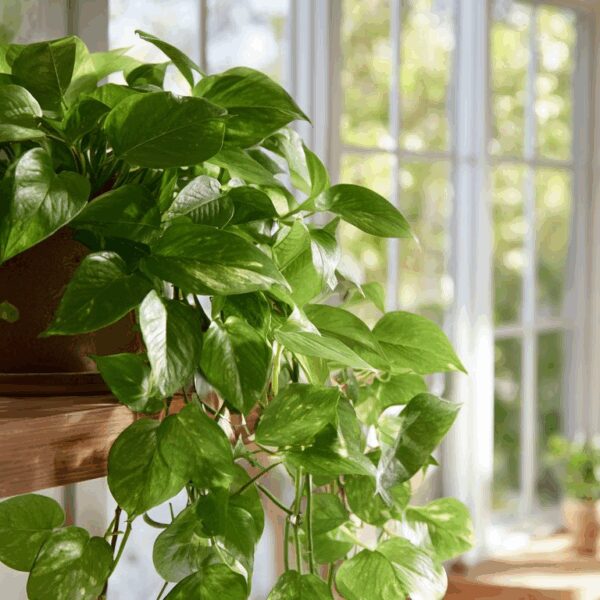If you have a Pothos at home and it’s starting to show yellow leaves, it’s like it’s sending you a little SOS. These beauties are pretty forgiving, but they can get fussy—overwatering is often the sneaky villain behind that discoloration.
🌱 Green Thumb Essentials in 4 Points:
- Yellow Leaves? 🌿 Your Pothos is thirsty for attention! If those leaves are turning yellow, it might be a sign of overwatering. Check for soggy soil—if it’s mushy, hold off on watering until it’s drier. Remember, they like their drink but not a bath!
- Leggy Growth? ☀️ Your plant is asking for more light! If you see long stems with sparse leaves, move your Pothos closer to a bright, indirect light source. A south or east-facing window works wonders. And don’t forget to rotate it occasionally for even growth!
- Brown Tips? 💧 Uh-oh, low humidity alert! As winter creeps in, your home might get too dry. Combat that by misting your Pothos or placing a humidifier nearby. A pebble tray can also do the trick—just make sure the roots don’t sit in water!
- Pest Patrol! 🐞 Keep an eye on those leaves. If you spot sticky spots or webbing, pests like spider mites might be moving in. Grab some insecticidal soap and wipe down those leaves regularly to keep your plant bug-free!
Yellow Leaves? Your Pothos Is Not Thriving
So, it’s November, and the days are getting shorter. If you’re noticing that your Pothos (Epipremnum aureum, also known as Devil’s Ivy) is developing yellow leaves, it’s time to pay attention. This could be a sign of overwatering, which is all too common with these beauties. They love their water, but they don’t want to sit in it! Make sure your pot has drainage holes and let the top inch of soil dry out before watering again. If the leaves are yellowing but not dropping, you might just need to adjust your watering routine.
Tip: Check for soggy soil; if it’s mushy, hold off on watering until it feels drier.
Leggy Growth? Light Levels Might Be Off
When your Pothos starts stretching out with long stems and sparse leaves, that’s its way of saying it needs more light. These plants thrive in bright, indirect sunlight. If you’ve got yours sitting in a dim corner or under a low-watt bulb, consider moving it closer to a window (but out of direct sunlight—burned leaves aren’t pretty!). A south or east-facing window typically works wonders.
Quick Fix: Rotate your plant every so often for even growth. Also, consider investing in a grow light if natural sunlight is limited during these shorter fall days.
The One Watering Mistake That’s Killing Your Snake Plant (Even Though It’s ‘Indestructible’)
Brown Tips? You Might Have a Humidity Problem
If you notice brown tips on the leaves of your Pothos, humidity could be the culprit. As temperatures drop in November, our homes can become super dry from heating systems kicking on. These plants love humidity! Try placing a humidifier nearby or misting the leaves regularly. For an extra boost, you can create a pebble tray filled with water beneath the pot—this helps increase moisture in the air without making the roots soggy.
Pro Tip: Grouping houseplants together can also help create a mini humid environment!
Pest Patrol: Check Your Leaves
This is an ongoing battle for many plant parents. If you see sticky spots or webbing on your Pothos leaves, those little pests may be moving in for winter. Spider mites and mealybugs love to sneak up on indoor plants during this time of year when they’re cozy inside. Take a closer look—if you spot any critters, grab some insecticidal soap from Home Depot or Lowe’s and spray those pests away. Regularly wiping down leaves with a damp cloth can also help keep them clean and less inviting to bugs.
Reminder: Inspect new plants before bringing them home to avoid introducing pests to your existing collection!
Your Plant Looks Droopy? Maybe It’s Thirsty
A droopy Pothos can be alarming but don’t panic just yet! This might just mean it’s thirsty. Check the soil; if it’s dry several inches down, give it a good drink! But if the soil is still wet and the plant looks sad, it could be suffering from root rot due to overwatering. In that case, gently remove it from its pot and inspect the roots—healthy roots should be firm and white.
Action Step: Prune any mushy roots away before repotting in fresh soil.
The Color’s Fading? Fertilization Time!
If your once-vibrant Pothos seems to have lost its luster this fall—maybe it’s looking pale or washed out—it might need some food! During this growing season leading into winter dormancy, fertilizing with something like Miracle-Gro Liquid Houseplant Food can give it the nutrients it needs to thrive before going dormant. Just remember not to overdo it; once every four weeks should keep your plant happy.
Sneaky Tip: Always dilute your fertilizer according to package instructions; stronger isn’t always better!







